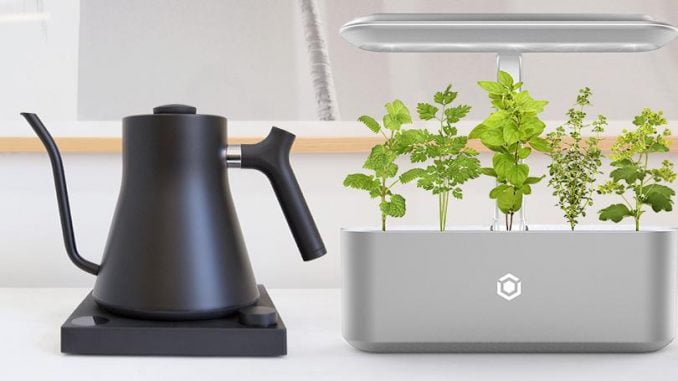

With the very public demise of Juicero, smart kitchen appliances are getting a bad rap. From “interactive centerpiece” SMALT (i.e. a salt shaker with speakers) to Tovala, a glorified Easy-Bake Oven with subscription meal kits, smart cooking fatigue may be setting in.
At this year’s Smart Kitchen Summit, a new wave of kitchen gadgets went beyond the gimmicks of single-use hardware. Granted, there are still some bizarre products in the works, but if Juicero-gate has taught startups in this space anything, it’s that they’ll need to deliver more than just Wi-Fi and speaker capabilities to get into people’s homes.
“One thing we have to ask is what actually makes kitchen products smart and different beyond traditional appliances?” said Valerie Song, CEO and co-founder of AVA, which launched its smart indoor garden Byte on Indiegogo in June; it was a finalist at the summit’s Food Tech Startup competition.

For Song, smart products should get better over time, not become obsolete and require a subscription model or expensive updates. “Can you build the software algorithm to make your product better?” she asked. If not, that kitchen gadget will sit in storage with other misguided impulse buys.
Paul Orlando, Incubator Director and Adjunct Professor at USC’s Lloyd Greif Center for Entrepreneurial Studies, agrees. “It’s important to ask whether the addition of the tech features makes the product better for the end customer or just for the business itself,” he told PCMag. Simply building a Wi-Fi-enabled kitchen gadget without improving the manual version—just for the sake of building—isn’t enough for customers to hastily add it to their cart.
For AVA’s entry-level gardening system—built with sensors and a camera hooked up to an app for data integration—its founders, both chefs, knew that designing a product with millennials and urban living in mind was vital.
“We’re seeing the trend of indoor kitchen and container growing has grown over 50 percent,” Song noted, so AVA’s hardware can be mounted to save counter and floor space, creating longevity for the product’s use.
Available for pre-order on Indiegogo now, an AVA Byte, plant pods, and Plant Vision HD Camera will set you back $229. An extra year’s supply of plants is $99. The company expects to start shipping in May.
For Fellow, which makes the EKG Kettles beloved by coffee nerds everywhere, simply creating a smart version of its popular Stagg EKG Pour-Over Kettle was never the plan. Extensive research and customer feedback suggested releasing a digital version of the stove top kettle (also a Smart Kitchen Summit finalist) was the savvier move.

“EKG is our first electronic product, which is new for us on the manufacturing side,” Hanna McPhee, Fellow’s Brand and Product Manager, told PCMag. “Our focus isn’t tech at all, it’s creating experiences for coffee lovers.”
Not surprisingly, the Fellow team was concerned about being lumped in with Juicero and other ill-fated, one-off devices.
 “We were nervous about launching a Kickstarter [that might be called] a ‘ridiculous item,’ for sure,” McPhee said. “So we made two versions, one connected and one not, because we knew some of our customers didn’t want to pay extra for the connectivity.”
“We were nervous about launching a Kickstarter [that might be called] a ‘ridiculous item,’ for sure,” McPhee said. “So we made two versions, one connected and one not, because we knew some of our customers didn’t want to pay extra for the connectivity.”
There’s a double-edged source with crowdsourcing, McPhee explained. It seems there are two ways to be successful in the connected kitchen space: launch something so absurd it stops the tech media in its tracks, or make a well-designed product for an already-existing customer base, such as the EKG’s.
While branding may be a major concern for the current crop of smart kitchen gadget makers, some are going the software route. Apps like Chefling, a virtual kitchen assistant, aim to de-clutter the busy chef’s kitchen.
 “Given the kitchen already comes with existing appliances, we wanted to take a different approach to easing most households’ hurdles,” said Jeff Xie, VP of Engineering at Chefling. “Hardware doesn’t always solve problems; for example: an IoT kettle still needs to be filled with water by a human.
“Given the kitchen already comes with existing appliances, we wanted to take a different approach to easing most households’ hurdles,” said Jeff Xie, VP of Engineering at Chefling. “Hardware doesn’t always solve problems; for example: an IoT kettle still needs to be filled with water by a human.
“What we’ve done is create a kitchen assistant using software for people who like the idea of reminders for expiration dates and waste reduction,” Xie explained.
Chefling’s software is broken down into three components—digital pantry, cookbook and shopping list. The team wants to get the platform to the point where it doesn’t rely on users to enter items, and with the help of grocery receipt and kitchen photos scans, it’s well on its way.
“Furthermore, the integration of the Amazon Echo and Google Home skills, Chefling becomes a full assistant to give you recipes and order ingredients when you say an item’s runs out,” Xie said.
It may be too soon to tell which smart kitchen gadget will survive. With Silicon Valley looking to infiltrate every industry, the bubble of funding and crowdsourcing of single-use gadgets is nowhere in sight. And as Orlando put it: “Let’s not forget that many people get value simply from having a cool new device.”
[“Source-pcmag”]
